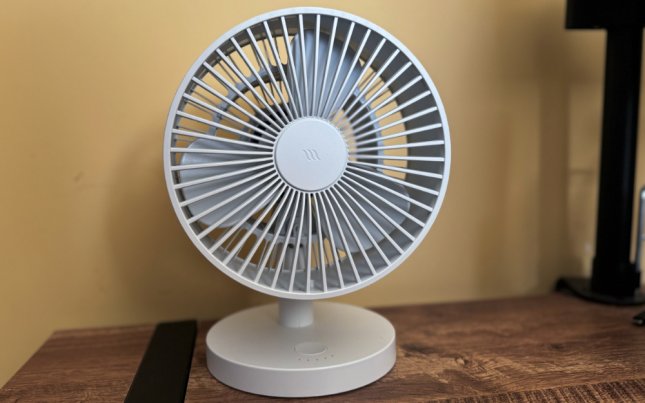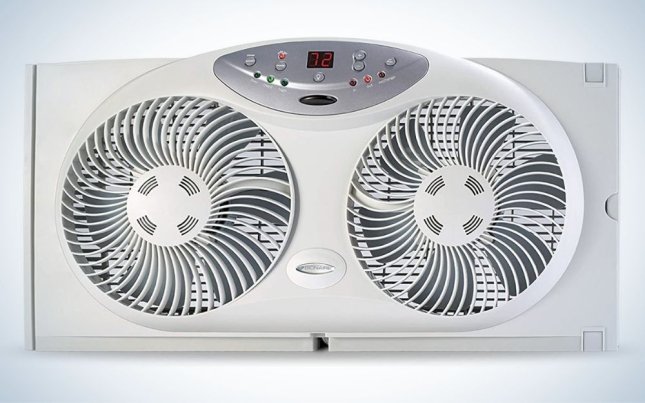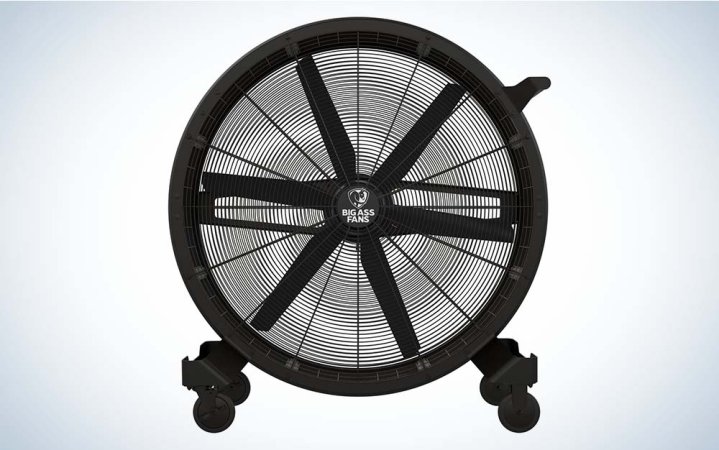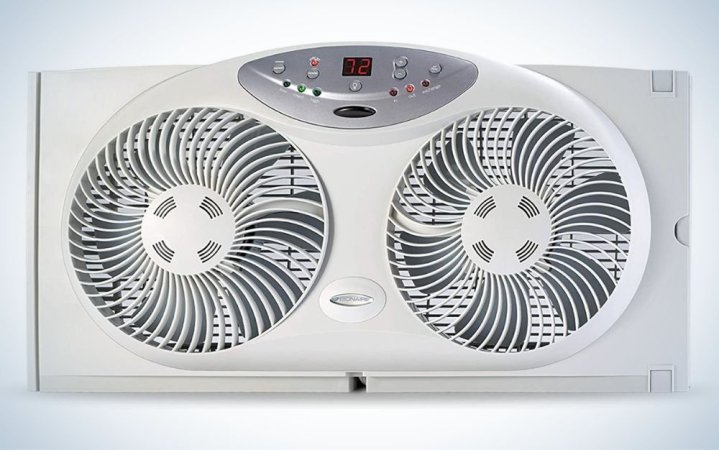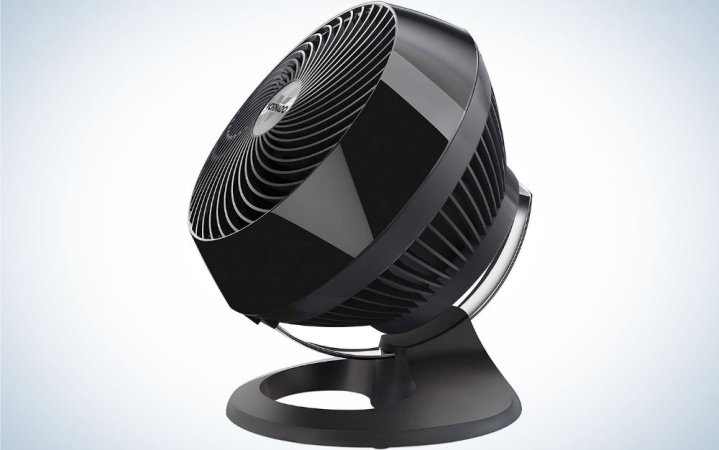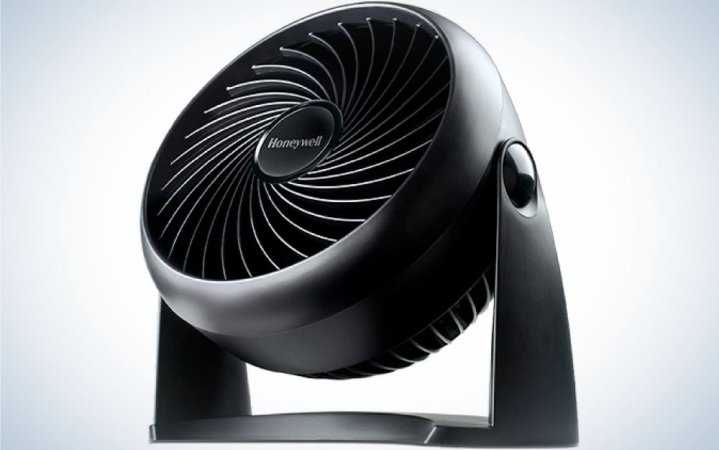We may earn revenue from the products available on this page and participate in affiliate programs. Learn more ›

As the thermostat rises, having a fan on hand for your home or outdoor adventure needs makes sense before the stifling summer weather makes you too lazy to shop. In addition to cooling you down without running up your electricity bill, an efficient one can help keep you healthy by stimulating air circulation. Science has confirmed that we hate being hot, and a quality fan could mean the difference between a pleasant evening or a poor night’s sleep. With that in mind, we’ve compiled this handy guide to the best fans to help you chill out and find relief from the sweltering heat.
- Best overall: Windmill Fan
- Best for large spaces: Big Ass Sidekick Portable Fan
- Best battery-powered: Shark FlexBreeze
- Best for window: Bionaire Window Fan w/ Twin 8.5-In. Blades
- Best for desk: Vornado 660 Large Whole Room Air Circulator Fan
- Best budget: Honeywell HT-900 TurboForce Air Circulator Fan
How we chose the best fans
Our fan recommendations are based on a combination of hands-on testing and research. When determining which fans to feature, we considered room size, fan size, and window type.
The best fans: Reviews & Recommendations
Whether you’re looking for the best fan for your bedroom to keep cool at night, a battery-powered portable fan to bring on your next camping trip, or deciding between the best window or electric fan, we’ve got cool choices for cooling down.
Best overall: Windmill Fan
Windmill Fan
Specs
- Size: 6.5 x 8 x 10.98 Inches
- Type: Desk
- Price: $79
Pros
- Clean, modern look
- Surprisingly quiet given its power
- Useful smart features
Cons
- No height adjustment
Windmill’s smart air conditioner impressed us mightily when we tested it last year, but the company’s new smart fan—pardon the pun—blew us away. It actually improved the aesthetics of our home office desk due in large part to Windmill’s focus on circles. The base of the fan is a circle, the face of the fan is a circle, the cutout in the middle is a circle, and around the back are two additional circular housings that hold the fan’s motors and other mechanisms. Viewed from the side, the fan looks like a layer cake suspended in mid-air. While looks aren’t everything, this is an object you’re likely to keep on top of your desk for years, and it’s helpful that Windmill took this into consideration.
The Windmill Fan has five speed settings—the first three were designed for standard desk fan use, while the fourth and fifth settings allow you to use the Windmill Fan as an air circulator. On its first setting, the Windmill Fan was inaudible, providing the equivalent of a pleasant breeze without creating a buzzing sound. This is especially important if you’d like some relief while presenting on a work call from home.
The second and third fan settings provided much more airflow while increasing the amount of ambient noise it made reasonable amount. The Windmill Fan was never too loud, but you wouldn’t want to crank it up during a work call. On its fourth and fifth settings (which Windmill calls High and Boost), a jetstream from this fan could be easily felt from about 12 feet away. This is overkill for typical desk fan use but helpful if you’d like to move a lot of air around a big room very quickly.
Windmill’s fan can be controlled in three ways: by pushing a button on its base, using the included remote, or through the company’s smartphone app on iOS or Android. We’re skeptical about making every electronic object “smart,” but found the process of connecting this fan to our Wi-Fi router simple enough. The entire setup process took about five minutes (we already had a Windmill account, which expedited it) so we could turn the fan on and adjust its speed settings from our smartphone. If you’re liable to lose the extra remote or prefer to keep the top of your desk as clean as possible, this fan’s smart-home functions are reasonable enough.
Our complaints about Windmill’s fan have nothing to do with what it does but rather what it can’t do. The fan has no height adjustment or oscillation function, so you’ll have to manually move it around (and potentially stack it on top of a book or two) to hit you at the correct angle. You can tilt the fan upward, which is helpful but not quite the same. As a first-generation gadget, though, it’s hard to find any significant fault with the Windmill Fan.
Best for large spaces: Big Ass Sidekick Portable Fan
Best industrial
Big Ass Sidekick Fan
Specs
- Size: 27 x 55 x 59.5 inches
- Type: Floor
- Price: $2,599
Pros
- Gigantic size
- IPX5 rating
- Comes pre-assembled
Cons
- Too big for indoor use
Cooling a big space can be challenging, so you need a powerful fan when you set out to do it. The Big Ass Sidekick Portable Fan is up for the job. This barrel fan is 48 inches wide, providing plenty of airflow from its six airfoils. Big Ass Fans says this model can move up to 15,000 cubic meters of air per minute at its highest speed. This means it’s only practical to use outdoors, but that’s perfectly fine if you live in a warmer climate year-round and have backyard space. The Sidekick comes fully assembled, and its swivel casters make it portable and lockable. It must be kept on wheels as its 275-pound weight would make it nearly impossible to move otherwise. With its IPX5 waterproof rating, the Sidekick can be exposed to water without damage. You should still keep it covered during intense rainstorms, but a small sprinkle shouldn’t cause concern. The Sidekick isn’t for everyone, but if you have intense fan needs in a huge space, there’s no better choice.
Best battery-powered: Shark FlexBreeze
Best battery-powered
Shark FlexBreeze
Specs
- Size: 13.77 x 13.77 x 37 inches
- Type: Floor
- Price: $199.99
Pros
- Modular design
- Magnetic remote
- Misting feature
Cons
- Cost
While it’s great to have a stationary fan that you can depend on, it’s also very helpful to have one you can take throughout your day. Shark’s FlexBreeze takes this concept to the next level by allowing you to detach the fan from its floor-standing base at the push of a button. Small feet at the mini-sized fan’s base fold outward, keeping it steady on top of a table. This lets you use the FlexBreeze in any situation, regardless of the size of your room or the position of your outlets. It’s perfectly reasonable to use this as a tower fan in your living room, then take it on a camping trip to provide cool comfort when you’re outdoors. This modular design is reminiscent of Shark’s vacuums, and the ability to use one fan in different contexts came in handy more than once.
Buttons that control all of the FlexBreeze’s core functions (fan speed, oscillation) can be found on top of its fan, but we found ourselves gravitating toward its included remote for one reason: it’s magnetic. A raised bump on the back of the remote fits perfectly into a slot on the back of the fan, and it’ll hold even when shaken. Including a remote is especially helpful when using a wireless fan because a big benefit is using hardware unencumbered by cables and wires.
In our tests, the FlexBreeze could blast a jet of cool air across a 12-foot room with no problem, even on its lower settings. The fan was audible at each power level, though higher ones did create enough sound to overpower other ambient noise like a clicking mechanical keyboard. This is fine if you’re using the FlexBreeze in a loud outdoor environment like a cookout, but less so if you need a quiet desk fan that can run eight hours a day without distraction. On that note, Shark says the FlexBreeze can last up to 24 hours per charge on its first power setting and oscillation turned off. We used it for about a dozen hours at various speeds and modes after fully topping it up and never ran into any issues.
One of the FlexBreeze’s optional features is a misting mode, which works by clipping an attachment onto the front of the fan and the other side onto a spigot used for a garden hose. The water flows to the attachment, where it’s lightly disbursed and blown toward you. You won’t get hit with a constant spray of hard water, but it’s the equivalent of a spritz you’d experience when using a spray bottle. Shark is explicit about only using this feature outdoors and never around areas with appliances or other electrical tools.
Shark’s FlexBreeze is not only the best battery-powered fan but also one of the most inventively designed models we’ve ever seen. It’s easy to take with you regardless of where it’s needed and can serve multiple purposes when necessary.
Best for windows: Bionaire Window Fan w/ Twin 8.5-In. Blades
Flip-It-and-Reverse-It
Specs
- Size: 4 x 24 x 12.8 inches
- Type: Window
- Price: $64.99
Pros
- Adjustable frame
- Three speed settings
- Comes with a remote
Cons
- Dated look
Bionaire’s Twin Window Fan is designed for those who want to stay cool without dedicating floor or desk space to a traditional fan or installing an air conditioner. Its most impressive technical feature is that it lets you control both blades individually, which means you can program it to bring in fresh air from outside, expel hot air from indoors, or do both simultaneously. Buttons on the fan’s face allow you to control its speed, mode, and airflow functions, but you can make adjustments wirelessly using the included remote. A small LCD screen in the center of the fan’s control panel shows the current temperature, and you can set the fan to turn on when your room gets too stuffy.
Bionaire designed its fan with adjustable sliders on the sides, which you can extend to accommodate windows up to 34 inches long. The minimum amount of space you’ll need to use this fan is two feet, so make your measurements ahead of time. While the Bionaire’s Twin Window Fan isn’t the best-looking gadget we’ve seen, it makes up for this in sheer utility. Don’t hesitate to pick one up if you’re trying to get cool and have a double-hung, vertical slider, or casement window.
Best desk: Vornado 660 Large Whole Room Air Circulator Fan
Sleek Circulation
Specs
- Size: 11.75 x 13.5 x 15 inches
- Type: Desk
- Price: $99.99
Pros
- Reaches up to 100 feet
- Vortex action airflow
- Four speed settings
Cons
- No remote
The Vornado 660 packs the performance of a large box fan into a package small enough to fit on an office desk or side table. The company says the fan uses a circulator designed to use a specific airflow that can disperse air more efficiently than similarly-sized models. Similarly, the fan can push air as far as 100 feet at its top speed, providing ample relief from across a room. There are four speed settings to choose from, up from the traditional three, so you’ll have a little extra control over its power. We can quibble with the fact that this fan doesn’t have welcome extras like a remote, but that doesn’t have a huge impact on its performance. If you’re short on space but want a fan that can deliver ample cool airflow from the top of a desk, this is the one.
Best budget: Honeywell HT-900 TurboForce Air Circulator Fan
Small but Mighty
Specs
- Size: 6.54 x 11 x 11.3 inches
- Type: Desk
- Price: $19.99
Pros
- Compact size
- Full vertical articulation
- Price
Cons
- Not designed for larger rooms
Honeywell’s HT-900 is an inexpensive, quiet fan for use in small to medium-sized rooms. It can’t oscillate, but you can pivot its head a full 90 degrees, which is significantly flexible. The fan is small and light enough that twisting and turning it occasionally as you move around a room won’t be a huge hassle. The HT-900 has all the essential settings you’ll need in a fan, including three speed settings, enough power to reach areas up to 27 feet away, and quiet operation. You’re not going to be able to use this fan to cool down large rooms, but it’s powerful and compact enough to provide relief in smaller bedrooms or a kitchen while cooking.
What to consider when shopping for the best fans
There are many factors to consider when deciding which fan is right for you. Below are the factors we considered most important when writing this guide.
Before you search for the best fan, measure the size of the room where you plan to use it. Most have several speed settings, but you’ll want to determine in advance that the one you bring home is powerful enough for your space. Another aspect to consider is how much sound it makes. Some, especially if they’re set to full-blast, can be quite loud, while others are so silent you might even forget they’re on. If you’re very sensitive to noise, you may want to consider a bladeless fan, which tends to produce much less of a din than traditional ones. But bladeless models are often more expensive, so if you want the latest technology, expect to pay a higher price.
Not to worry, though, because there are plenty of great picks for every budget. Most are cheaper than air conditioners and use less electricity, so buying one may help you save money. Also worth considering is whether you want one with a remote control or timer. If the temperature in your bedroom dips overnight, you might prefer one that you can turn off (or that is already off) before you get out of bed. Many are battery-powered so you can take them onto the patio or out in the yard. Other models, such as window fans, will bring fresh air inside by sucking in cooler air from the outside.
Airflow
If you’re looking for something that will not only make you feel cooler but actually lower your home’s temperature, window fans are the way to go. The key to making them work, however, is all about positioning. Inward-facing models bring in cool air from outside while outward-facing ones exhaust hot air from inside. To make the most out of your window unit, you might want to consider buying two of them and placing them on opposite sides of the room or house. Just be sure to put the inward-facing model on whichever side gets more shade to maximize the amount of cool air coming in.
Want even more control over airflow? Other window fans come with inward- and outward-facing blades that can be set individually. Dual window fans can help cool down any room, but they are especially helpful in the kitchen since they can expel heat and odors while bringing in fresh air from outside.
Bladeless fans
Bladeless fans (also known as air multipliers) work by utilizing entrainment, meaning the air surrounding the edges of this electric option will begin to flow in the direction of the breeze. Finally, because the ring is thinner at the front than at the back, a phenomenon known as the Coandă effect occurs, creating low pressure in the inner part and causing additional air to be sucked in from behind it. Considering the technological wizardry behind their sleek design, it’s no surprise that air multipliers are significantly more expensive than their traditional counterparts. But if money is not your main concern, bladeless fans can’t be beaten when it comes to functionality and aesthetics.
Battery power
If you’ve ever found yourself struggling to fall asleep in a stuffy tent, you may want to consider buying a battery-operated fan before going on your next camping trip. Even if you’re not an outdoorsy, adventurous person, this type can still make a great addition to your next picnic or keep mosquitoes away while sitting on the porch. The best thing about battery-powered models is that they are portable, but there are advantages and disadvantages depending on the situation.
The most important things to consider before you buy are the size and weight, plus how long the batteries will last. You probably won’t want to lug around a heavier fan if you’re going on a long hike, but if you just plan on using it on your patio or you’re taking it with you in an RV, you might appreciate the extra power that a bigger design provides. You’ll also want to consider whether the model runs on rechargeable or disposable batteries. Rechargeables are better for the environment, but if you don’t have a way to charge them, they won’t do you much good. Some battery-powered models also come with neat features such as a radio or lights, but using these add-ons will run the battery down faster. Need personal refreshment that takes up minimal space? Consider a neck fan.
Price
If you want to stay cool this summer without putting too much strain on your wallet, an inexpensive device can be a lifesaver. Mass-produced electric models have existed for over a century, and today, affordable options abound. Does anyone need an expensive bladeless fan? Not necessarily, but staying cool and circulating the air around you can make all the difference in your health. Although cheaper ones tend to lack bells and whistles like timers and remotes, if you can live without those extra features, there are plenty of models that you can pick up for a budget-friendly price point of less than $20.
FAQs
Bladeless fans are also called air multipliers because they’re specially designed to blow out more air than regular ones. But since they also come at such a steep price, whether or not they’re “better” for you will depend on your budget. Many on the market will keep you perfectly cool at a much lower price point.
When buying a fan, make sure it’s powerful enough to keep your space cool. The size of your room or home may dictate the best type of fan to choose. Some models are also noisier than others, so look for a quiet fan for your bedroom that won’t keep you up at night.
The best for summer depends on the space you plan to use it in and how hot it gets outside vs. inside. For example, if it’s cooler outside than inside, the best window model will help bring that cool air inside while exhausting hot air outside.
Final thoughts on the best fans
- Best overall: Windmill Fan
- Best for large spaces: Big Ass Sidekick Portable Fan
- Best battery-powered: Shark FlexBreeze
- Best for window: Bionaire Window Fan w/ Twin 8.5-In. Blades
- Best for desk: Vornado 660 Large Whole Room Air Circulator Fan
- Best budget: Honeywell HT-900 TurboForce Air Circulator Fan
The best fan for you is the one that keeps you comfortable. For most people, this will come down to how powerful the model is and whether or not it is a quiet fan. Beyond that, there are plenty of extra features that you may want (such as timers, remotes, and thermostats). But those bells and whistles may not be necessary if you’re just looking for a blast of cool air. Ultimately, the most important thing to remember when shopping is to buy it before the temperature goes up and while a variety of popular models are still in stock.
